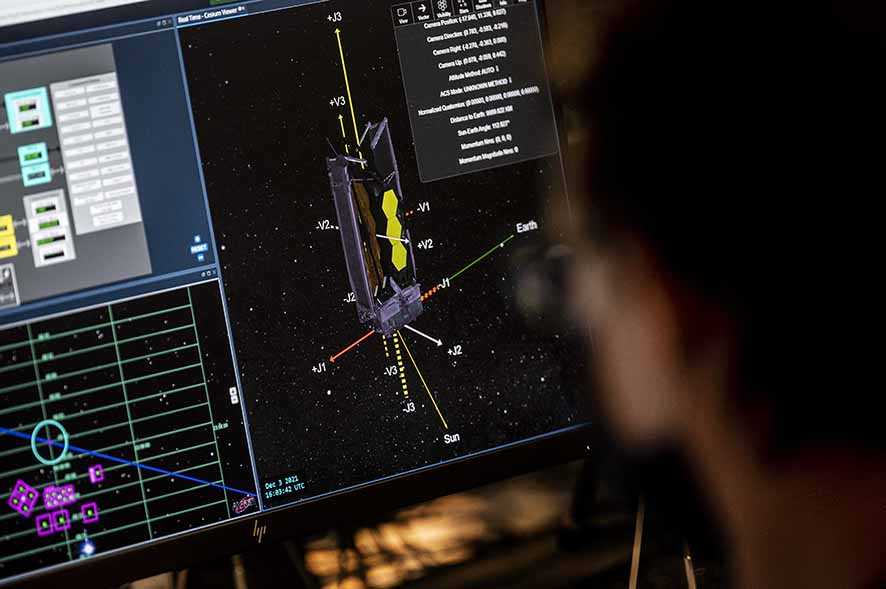The James Webb Space Telescope (JWST), has a main mirror measuring 6.5 meters wide, nearly three times the size of Hubble, and consists of 18 hexagonal segments. The mirror was so large that it had to be folded like origami when launched and stretched once in space.
To protect from solar radiation, this telescope is equipped with a kite-shaped sunshield the size of a tennis court. The sun visor is made of five layers of aluminum cladding that block out the sun’s heat and keep the telescope cool enough to operate.
The bottom side of the JWST sunshield will always face the sun, so the temperature reaches 85 degrees Celsius. While the other side, which is where the mirror and scientific instruments will have a very cold temperature, around minus 233 degrees Celsius.
The angular resolution of the JWST is very sharp and precise. This telescope can see at a resolution of 0.1 arc-second. In other words, being able to see a penny from 40 kilometers away or watching a football game from 550 kilometers away.
This mirror is almost three times the size of the Hubble mirror, so its light-gathering area is seven times larger than Hubble’s. However, these two mirrors have almost the same weight because of the lighter material used in this JWST mirror.
With large mirrors and a series of sensitive instruments, it is believed that what is obtained will surpass previous inventions of infrared space telescopes.
“This will change a lot of what we know about many areas of astronomy,” said astronomer at the Rochester Institute of Technology in New York, Jeyhan Kartaltepe, as quoted by Nature.
Kartaltepe said, if the launch is successful and JWST is operational, it is hoped that the view of space objects will improve. The appearance of very distant galaxies, nearby exoplanets, colorful nebulae, and more amazing astrophysical phenomena will be produced.
The telescope can study the dust that surrounds the star-forming regions as well as the gas between stars, neither of which is visible at shorter wavelengths. Like Hubble, the tool works by taking the spectrum of an astronomical object and dividing its light into its components to determine the material that composes it.
JWST’s ability to see faint red objects has even enabled it to observe some of the first stars and galaxies to form after the Big Bang that occurred 13.8 billion years ago. That way, this telescope almost certainly breaks the record for the farthest galaxy ever observed, namely GN-z11 which is located 13.4 billion light years from Earth.
The Webb infrared telescope will investigate many things including the period from about 400,000 years to 1 billion years after the Big Bang. In theory, this period is the time for the first stars and galaxies to shine in the universe. This era is known as the era of cosmic reionization, setting the stage for later galaxies that exist today to evolve.
“There’s a lot we don’t know about that time period,” said Kartaltepe, who co-leads the Cosmos-Webb project.
Through observations of these very distant astronomical objects, scientists can answer questions such as how the first stars gathered into galaxies. It can also answer how the galaxies evolved over time.
Astronomer at Leiden Observatory in the Netherlands, Mariska Kriek, plans to use Webb to study distant galaxies that no longer form stars. Observations will reveal the chemical composition of the stars in the galaxy and the speed at which they move.
The data, in turn, will help Kriek unravel the mystery of how and why these galaxies stopped forming stars at some point in their history.
“We’re looking for a very, very faint signal. This is really what James Webb will reveal,” he said.
JWST will also be used to research planets, particularly some of the thousands that have been discovered outside the solar system. Some of the most famous exoplanets, including seven Earth-sized worlds orbiting TRAPPIST-1 stars such as K2-141b. It is 1.5 times the size of Earth and moves so close to its star that some of it melts.
This is a rare example of a ‘lava planet’ with a geology unlike anything known in the solar system. JWST’s infrared vision can detect minerals in K2-141b’s atmosphere that have evaporated from its surface, and the observatory may even map temperatures across the planet.
“Webb is opening up many avenues for exoplanetary science that didn’t exist before,” said Lisa Dang, an astrophysicist and graduate student at McGill University in Montreal, Canada. hi/I-1
Also Read:
Editor : Ilham Sudrajat
Writer : Haryo Brono
– .


